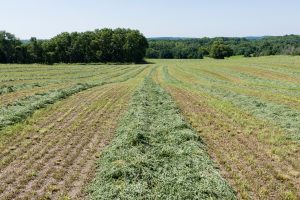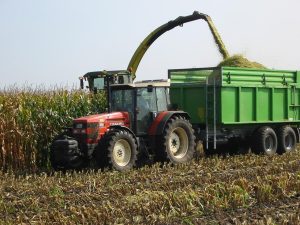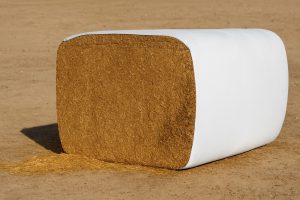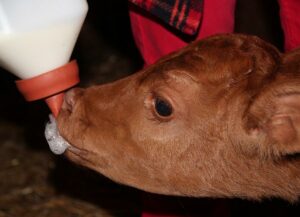Álvaro García
Silage making is often described as an exercise in preservation. In most cases, the best outcome we can achieve is to conserve the nutrients that were present in the crop at harvest. The fermentation process, when done correctly, locks in energy, protein, and fiber quality, protecting them from spoilage and loss during storage. In that sense, silage is not about “creating” more nutrition, but about safeguarding what the plant had to offer in the field.
There are exceptions, however, where ensiling can enhance the feeding value of a crop. One well-recognized example is corn silage. During fermentation, the acidic environment softens the protein matrix that encases starch granules in the kernel. This breakdown improves starch digestibility in the rumen and small intestine, allowing cattle to extract more energy per pound of dry matter than they would from freshly harvested corn plants. Similarly, the mechanical action of kernel processors combined with fermentation makes more starch available to the cow.
Forages like alfalfa or small grains do not gain nutrients during ensiling, but fermentation can still improve their usability. When inoculants are applied, lactic acid bacteria drive a rapid drop in pH, which both preserves nutrients and can partially break down plant cell walls. This modest structural alteration may increase fiber digestibility, improving the overall energy supply to the animal. In wetter small-grain silages, specific inoculants can also reduce undesirable fermentations, cutting down on butyric acid and spoilage organisms that would otherwise reduce feed value.
In short, while silage making is primarily a tool to preserve, there are unique instances where it can also enhance. The goal is to harvest at the right stage, process, and pack correctly, and use microbial tools strategically so that what goes into the silo not only lasts but, in some cases, feeds better than the crop itself.
Corn silage
Corn silage is the foundation of dairy and beef rations across the U.S. and other parts of the world, and with good reason: it provides a unique blend of digestible fiber and starch energy in a single package. But realizing its full potential requires precision in harvest timing, processing, and storage. The classic indicator for harvest readiness is kernel milk line, ideally between one-half and two-thirds. At this stage, whole-plant dry matter typically runs 32–35%. This is the sweet spot: fiber digestibility remains high, while starch concentration and kernel maturity are advanced enough to maximize energy capture. Harvesting too early (above 70% milk line) risks excessive moisture, seepage losses, and reduced starch concentration. Waiting too long leads to overly mature kernels that resist breakdown in the rumen and reduced neutral detergent fiber digestibility (NDFd).
One of the greatest nutritional advantages of silage over standing corn is the effect of fermentation on kernel structure. As silage ferments, the acidic environment softens the protein matrix around starch granules, improving digestibility. Research has shown that starch digestibility can increase by 10–15 percentage units between fresh silage and well-fermented material after 3–4 months in storage. This effect is magnified when kernel processors are properly set — typically a 1–2 mm roller gap — to ensure that no whole kernels pass through unbroken. A simple “float test” in a bucket of water after chopping can verify processing quality: if more than 2 kernels per handful remain intact, processor adjustment is needed.
Maximizing fiber, energy, and nutritional value in corn silage
Harvest timing, particle size, and storage management all converge to determine how much of the crop’s potential feed value reaches the cow. As corn plants mature, lignin content rises and reduces fiber digestibility, even as starch levels in the kernels increase. The recommended harvest target of 32–35% dry matter (DM) strikes the best balance between fiber and starch availability. Some dairy producers lean slightly wetter (30–32% DM) to capture more digestible fiber for high-forage rations, while beef producers may push drier (up to 37% DM) to maximize starch concentration for finishing diets.
Chop length and packing density are equally important. For modern total mixed ration (TMR) systems, a theoretical length of cut (TLC) around ¾ inch (19 mm) with kernel processors engaged provides enough effective fiber for rumination while still allowing tight packing. Oxygen exclusion is critical; densities of at least 14 lb. DM/ft³ (225 kg DM/m³) are the benchmark, often requiring multiple heavy tractors working continuously across the pile. Poor packing can quickly undermine good harvest timing by opening the door to heating and spoilage.
When executed correctly, corn silage does more than preserve nutrients — it enhances them. Kernel processing softens grain, increasing starch digestibility beyond what raw corn offers, while fermentation stabilizes the entire forage mass. This improved feed value explains why corn silage has become the backbone of dairy diets, often making up 30–50% of ration dry matter, and a key energy source in beef finishing programs at 30–40%. Its consistent nutrient supply and high palatability reduce ration sorting and help maintain stable rumen fermentation, two cornerstones of efficient animal performance.
Alfalfa silage (haylage)
Alfalfa is the basis of many forage programs, providing highly digestible fiber and protein that complement corn silage in cattle diets. Unlike corn, which is managed by dry matter content and kernel maturity, alfalfa’s feed value relies on overall plant maturity at harvest. The optimum window for alfalfa harvest is late bud to early bloom. At this stage, neutral detergent fiber (NDF) typically runs 35–40%, which balances digestibility and yield. Cutting earlier, in the vegetative to early bud stage, produces forage with exceptional digestibility and crude protein (often >22% CP), but yield per acre is lower and stand persistence can be compromised. Delaying harvest into mid- or full bloom increases yield, but fiber lignification accelerates, reducing digestibility and intake potential.
Producers should think in terms of “relative forage quality” (RFQ), a measure that integrates both digestibility and fiber content. Targeting RFQ values between 150 and 170 maximizes animal performance without sacrificing too much tonnage.
For ensiling, alfalfa should be wilted to 35–45% dry matter (DM). Wetter forage increases the risk of clostridial fermentation, leading to high butyric acid and reduced intake. Excessively dry forage (>50% DM) is difficult to pack, increasing porosity and spoilage. Rapid wilting is key: wide swathing immediately after cutting, followed by tedding or merging within 24 hours, helps reach the target DM quickly and minimizes respiration losses.
Alfalfa haylage: Timing, processing, and payoff
Making top-quality alfalfa haylage is a balancing act between yield and digestibility. The optimum harvest window is late bud to early bloom when neutral detergent fiber (NDF) is typically 35–40%. Cutting earlier improves fiber digestibility and animal performance but sacrifices tonnage, while later harvest boosts yield at the expense of quality. Aligning the harvest stage with herd goals is key: high-output dairies benefit from early, digestible forage, whereas lower-input systems may accept slightly more mature haylage for higher yields and stand persistence.
Once cut, the crop must be processed for proper storage. Aiming for a TLC between ⅜ and ½ inch (9–13 mm) strikes a good balance, encouraging tight packing without sacrificing effective fiber. If the forage is drier than ideal, chopping shorter helps increase density in the silo. The packing target is the same as for corn silage, at least 14 lb. DM/ft³ (225 kg DM/m³) to exclude oxygen and prevent heating.
Fermentation presents a special challenge in alfalfa, which contains fewer natural sugars and a higher buffering capacity than corn. This makes inoculants especially valuable. Strains of Lactiplantibacillus plantarum accelerate lactic acid production and lower pH more quickly, while Lentilactobacillus buchneri helps control heating and spoilage during feedout. Choosing the right inoculant can mean the difference between a stable, palatable haylage and one that molds, loses digestibility, and drives down intake at the bunk.
When done right, alfalfa haylage delivers highly digestible fiber that stimulates chewing and maintains rumen health, along with substantial protein that reduces the need for expensive supplements such as soybean meal. In many dairy herds it supplies 15–25% of total ration dry matter, paired with corn silage for energy. Beef producers use it to add protein and palatability in growing or backgrounding diets. In all cases, success comes down to precision, harvesting at the right stage, chopping to the right length, and ensuring airtight fermentation to preserve both nutrients and economic value.
Small-grain silage
Small grain forages, including rye, triticale, wheat, barley, and oats, offer producers a useful tool to extend the forage calendar, capture fall, or early spring growth, and improve land use efficiency. While they rarely reach the energy density of corn silage, when harvested and managed properly they provide valuable forage that complements other ensiled feeds.
Timing and stage of harvest
The most critical factor in small grain silage quality is the stage of maturity at harvest.
- Boot stage: Highest digestibility and protein (15–20% CP), but lowest yield. Excellent for lactating dairy cows or fast-growing stockers, but less suited for maximizing tonnage.
- Soft dough stage: Maximum yield, higher starch content, but much lower fiber digestibility. Protein levels often drop below 10%. Better for dry cows or beef rations.
- Flag leaf to early heading: Represents a middle ground, producing forage with moderate digestibility and acceptable yields. This is the stage most recommended for dairy quality silage.
Producers should align harvest stage with their herd’s nutritional needs. For example, cutting rye at boot stage for dairy and allowing triticale to reach heading for heifers or beef cattle maximizes flexibility.
Harvesting and ensiling small grain silage
Successful preservation of small grains like rye, triticale, barley, or wheat relies on careful control of dry matter, chop length, and fermentation management. Target dry matter content at ensiling is 32–38%. Because these crops are typically wetter at the boot or heading stage, wilting is often required. Wide-swathing right after mowing and using conditioners to crush stems help speed moisture loss. Any delay in wilting or silo filling risks respiration losses of soluble sugars, already in limited supply compared to corn.
For chopping, a TLC of ⅜–½ inch (9–13 mm) is recommended, like alfalfa, to strike a balance between good packing and maintaining some effective fiber for rumen health. Kernel processing is unnecessary, but if the crop is harvested later at the soft-dough stage, when grains are filling, rolling or light processing may enhance starch digestibility.
Fermentation poses a challenge because small grains have lower sugar content and higher buffering capacity than corn. That is why inoculants are often essential. Strains of Lactiplantibacillus plantarum accelerate acidification and stabilize pH quickly, while Lentilactobacillus buchneri helps control aerobic spoilage and prolong bunk life, particularly critical when silage is exposed in warm weather.
The role of small grain silages in rations and systems
Small grain silages occupy a unique niche in forage programs, offering a nutritional and agronomic complement to corn and alfalfa. On a nutrient basis, they provide less energy than corn silage (typically 0.60–0.65 Mcal NEl/lb. DM compared with 0.70–0.74) but contribute more effective fiber. Protein levels are highest when harvested early, ranging from 15–20%, but steadily decline as plants mature. This makes them especially useful in dairy rations where high-quality alfalfa is scarce, helping balance rumen function and protein supply. In beef systems, later-harvested small grains serve as a cost-effective source of bulk and energy for maintenance or backgrounding, reducing reliance on purchased feeds.
The benefits of small grains extend beyond animal performance. As part of a whole-farm strategy, they provide valuable system advantages. Fall-seeded rye or triticale harvested in the allows for double-cropping with corn or soybeans, maximizing land productivity. Their rapid growth helps protect soil from erosion, while their extensive root systems capture residual nutrients, particularly nitrogen, which might otherwise leach during the winter.
Small grain silages are not a one-size-fits-all feed. Their value depends on harvest timing and production goals: initial stages deliver higher digestibility and protein, while later harvests emphasize yield and starch. With careful management of wilting, chopping, packing, and fermentation, they become a versatile and reliable forage option, filling seasonal feed gaps and enhancing ration flexibility across both dairy and beef operations.
Building the pile
Harvested forage should be delivered and packed without delay, since plant respiration and heating begin the moment, it is cut. To minimize losses, filling must proceed in layers no thicker than 15 centimeters (6 inches), which allows tractors to compact the material effectively.
Packing density depends on three key factors: layer thickness, tractor weight, and the number of passes. A practical rule of thumb is that for every ton of forage delivered per hour, there should be 800 pounds of tractor weight working on the pile. For instance, if 100 tons arrive in one hour, tractors with a combined weight of 80,000 pounds are required. This can be achieved with a single heavy machine or several smaller ones. Tire configuration also matters wide or dual tires distribute weight over a larger area, reducing pressure per square inch, which means extra passes are needed compared to narrow tires.
The goal is to reach a packing density of at least 15 pounds of dry matter per cubic foot (240 kg/m³). Achieving this level of compaction minimizes oxygen infiltration, promotes stable fermentation, and preserves the nutritional value of the silage.
Sealing and protecting
Proper sealing is the last step in protecting forage investment. Oxygen is the greatest enemy of silage quality; it allows heating, mold growth, and nutrient loss. Cover piles immediately after filling with plastic, weighted securely to prevent air infiltration.
Tarp technology has evolved in recent years. Standard black-and-white polyethylene remains widely used because it is affordable and provides good protection from sunlight. However, newer multi-layer oxygen-barrier films, often with nylon or EVOH layers, reduce oxygen penetration, cutting surface spoilage and improving aerobic stability during feedout. While they cost more upfront, the reduction in dry matter losses can offset the expense, especially in high-value forages. Some farms are also adopting integrated two-step systems, where a thin oxygen-barrier film is placed directly on the silage and covered with a heavier protective sheet for durability. Regardless of the tarp type, sidewalls must be sealed tightly, and overlaps secured with gravel bags or tires placed edge to edge, to keep air and water out.
The bottom line
Silage making is not just about cutting and storing forage, it is a system where timing, chopping, packing, and sealing all interact. Harvest too late, chop too long, pack too lightly, or seal poorly, and the losses multiply. Done right, however, silage delivers high-energy feed, consistent performance, and the economic payoff of preserving every bit of the forage crop you worked so hard to grow.
The full list of references used in this article is available upon request.
© 2025 Dellait Knowledge Center. All Rights Reserved.








